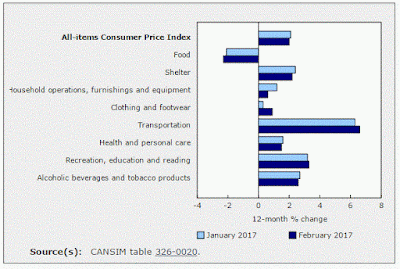What Is your "Real" Return?
I received an excellent question from a client this week about the difference between "nominal" returns and "real" returns.
Simply put, nominal returns are your actual total annualized rate of return. If your total portfolio return over the last year is 10% and you allow about 1.5% for fees and taxes (taxes will only be those paid on income, dividends and realized capital gains in a non-registered portfolio, as there is none to pay in a registered portfolio or TFSA), then you have a nominal return of approx. 8.5%.
"Real" returns take into consideration the annual increase in your cost of living (inflation).
This morning, Statistics Canada released data that tells us that a basket of goods of consumer items (listed in the above Consumer Price Index chart) which they track for us, increased in price by 2% from last February until February 2017.
The difficulty is that each of us consumes somewhat differently and may not have the same basket of consumer items. To understand our own cost of living and year to year increases, we have to track our own spending habits.
We try to do this in our client Wealth Forecasts as we track how our clients spend from year to year. However, we have to make assumptions about how their cost of living will adjust into the future (based on this historical input).
If we are a little bit conservative, and estimate the annual cost of living at or about 2.5%, the "real" rate of return would equal your "nominal" return (say 8.5%) less the cost of living allowance (2.5%), which would give you the "real" return of 6%.
Of course, this annualized number is rather simple, but it is relevant because you need to know that you are growing your money at a rate that is ahead of your cost of living and reducing the likelihood of running out of money.
The complexity comes into play as we look out multiple years and take the compounding of both nominal returns and inflated costs of living into consideration.
Hence the Wealth Forecast that we (at High Rock) create and review every 6 months with our clients (our stewardship of your financial health), so that we can understand how these returns are expected to progress in the years to come.
However, it does have to be an on-going process, whereby we monitor how we are progressing against previous forecasts (6 month review) to determine if our investing strategy is driving you to your goals and if we need to adjust our assumptions (like cost of living increase) or the investing strategy itself.
And of course this is a long-term approach to the growth of our wealth, so simple year to year changes are going to be smoothed out over those longer periods of time.
Love to get your questions...
If you would like to receive this blog directly to your inbox...


No comments:
Post a Comment